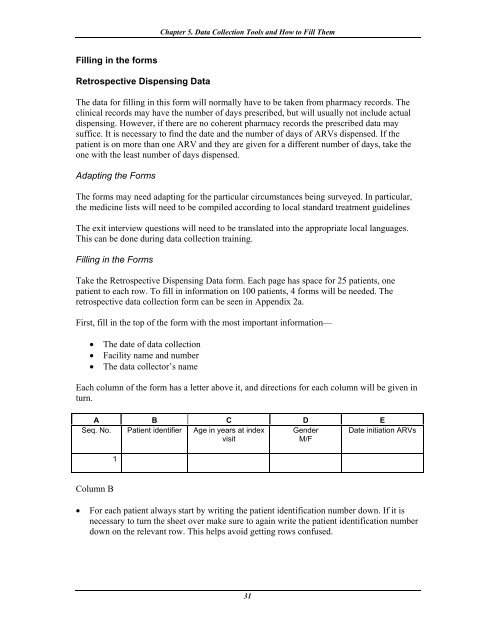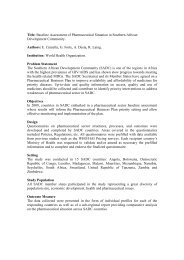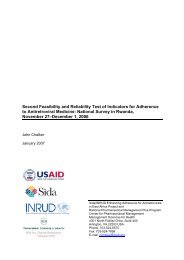How to investigate Adherence to Antiretroviral Treatment ... - INRUD
How to investigate Adherence to Antiretroviral Treatment ... - INRUD
How to investigate Adherence to Antiretroviral Treatment ... - INRUD
You also want an ePaper? Increase the reach of your titles
YUMPU automatically turns print PDFs into web optimized ePapers that Google loves.
Chapter 5. Data Collection Tools and <strong>How</strong> <strong>to</strong> Fill Them<br />
Filling in the forms<br />
Retrospective Dispensing Data<br />
The data for filling in this form will normally have <strong>to</strong> be taken from pharmacy records. The<br />
clinical records may have the number of days prescribed, but will usually not include actual<br />
dispensing. <strong>How</strong>ever, if there are no coherent pharmacy records the prescribed data may<br />
suffice. It is necessary <strong>to</strong> find the date and the number of days of ARVs dispensed. If the<br />
patient is on more than one ARV and they are given for a different number of days, take the<br />
one with the least number of days dispensed.<br />
Adapting the Forms<br />
The forms may need adapting for the particular circumstances being surveyed. In particular,<br />
the medicine lists will need <strong>to</strong> be compiled according <strong>to</strong> local standard treatment guidelines<br />
The exit interview questions will need <strong>to</strong> be translated in<strong>to</strong> the appropriate local languages.<br />
This can be done during data collection training.<br />
Filling in the Forms<br />
Take the Retrospective Dispensing Data form. Each page has space for 25 patients, one<br />
patient <strong>to</strong> each row. To fill in information on 100 patients, 4 forms will be needed. The<br />
retrospective data collection form can be seen in Appendix 2a.<br />
First, fill in the <strong>to</strong>p of the form with the most important information—<br />
• The date of data collection<br />
• Facility name and number<br />
• The data collec<strong>to</strong>r’s name<br />
Each column of the form has a letter above it, and directions for each column will be given in<br />
turn.<br />
A B C D E<br />
Seq. No. Patient identifier Age in years at index Gender Date initiation ARVs<br />
visit<br />
M/F<br />
1<br />
Column B<br />
• For each patient always start by writing the patient identification number down. If it is<br />
necessary <strong>to</strong> turn the sheet over make sure <strong>to</strong> again write the patient identification number<br />
down on the relevant row. This helps avoid getting rows confused.<br />
31
















